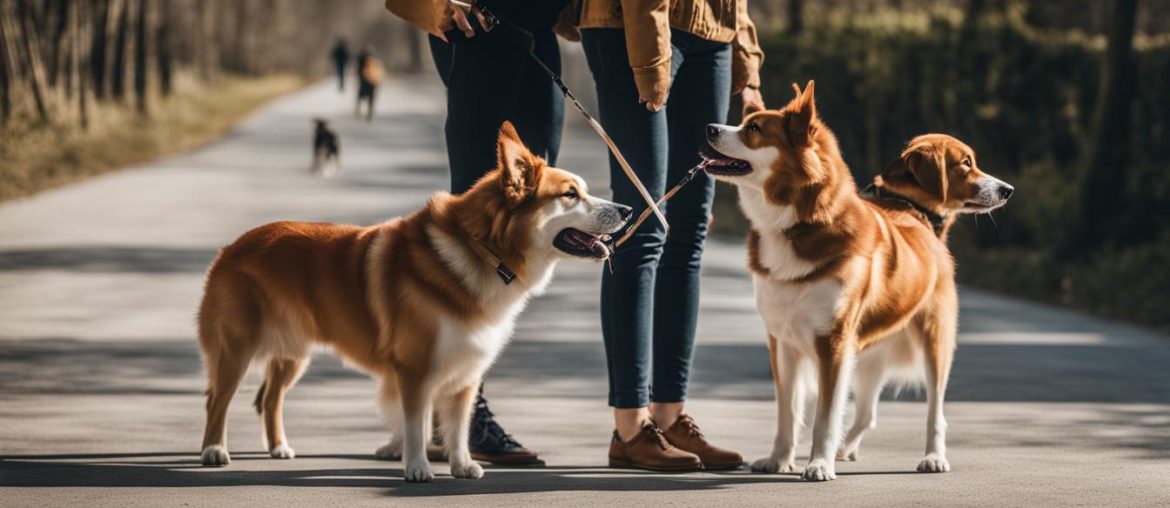As a responsible dog owner, it is crucial to know how to intervene in a dog fight safely and effectively. Dog fights can be intense and dangerous, and understanding the right techniques can prevent injuries to both dogs and humans. In this section, I will discuss the importance of recognizing dog body language and offer tips on breaking up a dog fight without putting yourself at risk.
Key Takeaways:
- Recognize the signs of stress and aggression in dogs to prevent fights.
- Use distraction techniques and objects to safely separate fighting dogs.
- Evaluate the situation and determine the best intervention technique based on the intensity of the fight.
- Understanding triggers for aggressive behavior can help prevent dog fights.
- Prioritize safety and seek veterinary care if necessary.
Understanding Dog Body Language
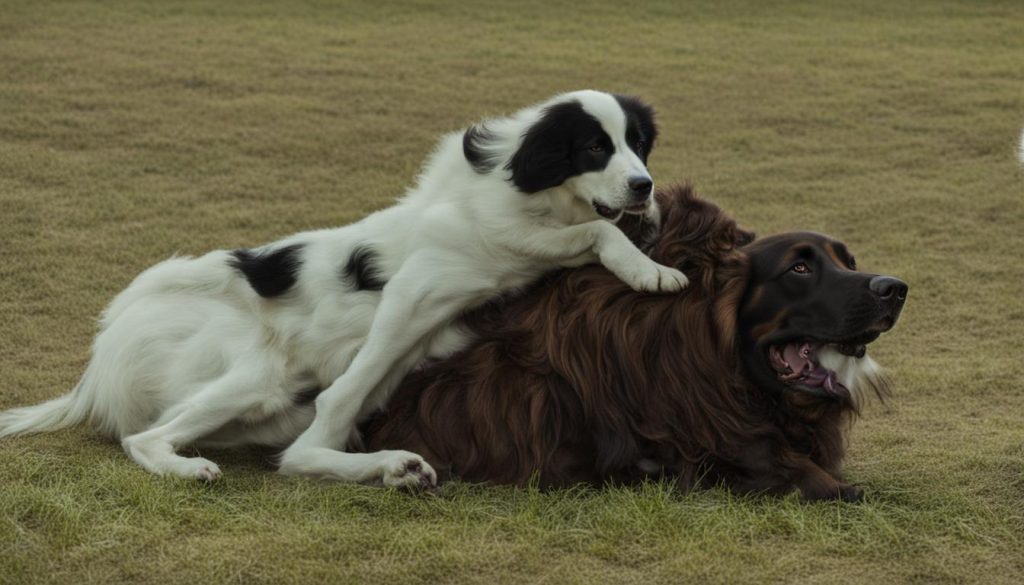
Recognizing and understanding dog body language is crucial when it comes to preventing and stopping dog fights. Dogs communicate through a range of visual cues, and being able to interpret these signals can help avoid potential conflicts. Some key signs of stress or aggression to look out for include growling, tucking the tail, flattened ears, and whale eye (showing the whites of the eyes).
Additionally, lip licking, pacing, and excessive sniffing can indicate that a dog is feeling stressed or anxious. These behaviors may suggest that a dog is uncomfortable in a particular situation and could potentially escalate into aggression if not addressed. By understanding these body language cues, you can predict and preemptively intervene in a potential dog fight.
It’s important to note that dog body language can vary based on individual temperament and breed. Some dogs may exhibit unique behaviors or have different thresholds for stress and aggression. Therefore, it’s essential to spend time observing and getting to know your own dog’s body language to better understand their communication style and potential triggers for aggression.
Interpreting Dog Facial Expressions
| Facial Expression | Meaning |
|---|---|
| Relaxed face with soft, open mouth | Content and relaxed |
| Ears up and forward | Alert and interested |
| Tight, closed mouth with curled lips | Sign of stress or potential aggression |
| Showing teeth, snarling | Aggressive and defensive |
| Yawning | Sign of stress or unease |
Remember, every dog is an individual, and there can be variations in body language. It’s important to consider the context, the dog’s overall behavior, and their individual personality when interpreting body language cues. By being attentive and responsive to your dog’s body language, you can help maintain a safe and harmonious environment, reducing the risk of dog fights.
Breaking Up a Dog Fight: Safety First
When it comes to breaking up a dog fight, prioritizing safety is of utmost importance. It’s crucial to remember that intervening in a fight can be risky, and putting yourself in harm’s way should be avoided at all costs. Instead, focus on using distraction techniques to redirect the dogs’ attention and physically separating them using safe methods.
One effective distraction technique is making loud noises, such as clapping your hands or using a whistle, to startle the dogs and interrupt their fight. Another option is to use a spray bottle filled with water to spray them, which can help break their focus and prevent further aggression.
Physical separation can be achieved by using objects like a metal garbage can lid or a chair. Place the object between the dogs, creating a physical barrier that prevents them from attacking each other. The goal is to create a safe distance between the dogs until they calm down.
In more extreme cases, the wheelbarrow technique can be employed with the help of another person. Each person takes hold of a dog’s hind legs and lifts them off the ground, effectively immobilizing the dogs and preventing them from continuing their fight.
Remember, breaking up a dog fight should always prioritize safety. If you find yourself in a situation where intervening directly is too risky, it’s best to seek professional help or wait until the dogs separate on their own. Your well-being and the well-being of the dogs should be the top considerations.
| Distraction Techniques | Physical Separation Methods |
|---|---|
| 1. Loud noises (clapping hands, using a whistle) | 1. Metal garbage can lid |
| 2. Spraying water with a spray bottle | 2. Chair |
| 3. Wheelbarrow technique (with the help of another person) |
Steps to Break Up a Dog Fight
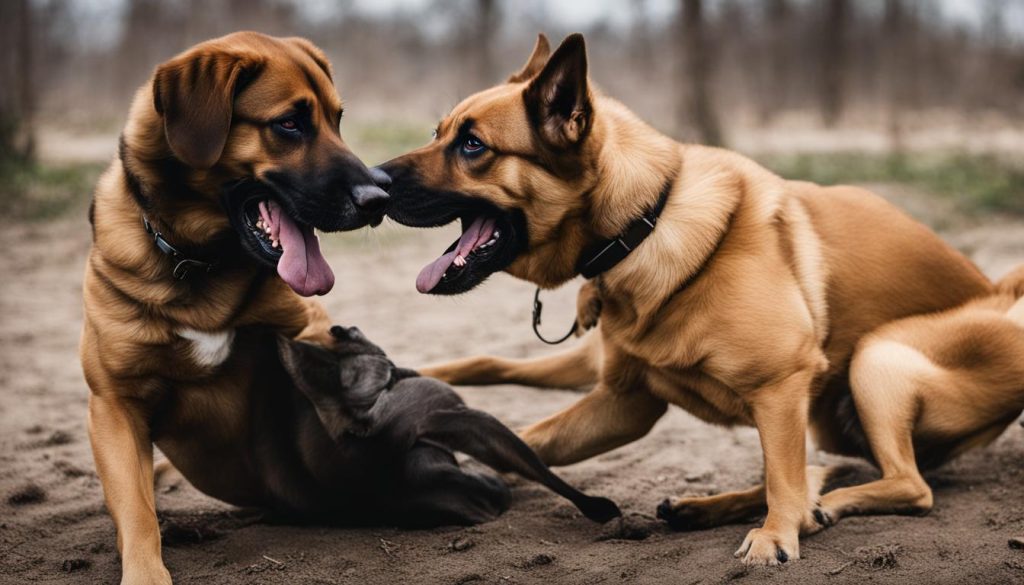
When faced with a dog fight, it’s crucial to act quickly and effectively to ensure the safety of both dogs involved. Here are the steps to follow:
1. Assess the Situation
Before intervening, it’s important to evaluate the intensity of the fight and the potential risk of injury. If the dogs are engaged in a scuffle fight with no severe biting or grabbing, it may be best to let them resolve it on their own. However, if the fight is intense and poses a high risk of injury, immediate intervention is necessary.
2. Determine the Aggressor
Once you decide to intervene, identify the aggressor dog. This is the dog showing more intense aggression and initiating the fight. By focusing your efforts on separating the aggressor, you can effectively stop the fight.
3. Break Any Jaw Grip
If either dog has a strong jaw grip, it’s crucial to break it to prevent further injury. Use a sturdy object like a thick blanket or a leash to pry open the dog’s mouth carefully. Avoid putting yourself at risk by directly attempting to separate their jaws with your hands.
4. Utilize Intervention Techniques
Depending on the intensity of the fight, there are different intervention techniques you can employ. For less intense fights, you can try leashed separation by walking each dog in opposite directions, gradually increasing the distance between them. In more severe situations, the wheelbarrow method can be used with the help of another person. This involves each person grabbing a dog’s back legs and lifting them, preventing them from reaching each other.
Remember, in any intervention, prioritize your safety and avoid direct contact with the dogs’ mouths. It’s also essential to provide a calm and comforting environment for both dogs after the fight, ensuring they receive any necessary medical attention if injuries are present.
| Steps to Break Up a Dog Fight |
|---|
| 1. Assess the Situation |
| 2. Determine the Aggressor |
| 3. Break Any Jaw Grip |
| 4. Utilize Intervention Techniques |
Preventing Dog Fights: Understanding Triggers

Preventing dog fights is essential for the safety of both your own dog and other dogs they may encounter. By understanding the triggers that can lead to aggressive behavior, you can take proactive steps to avoid potentially dangerous situations.
One common trigger for dog fights is resource guarding. Dogs can become possessive over food, toys, or other valuable items, which can escalate into aggression if not properly managed. It’s important to teach your dog to share and to create a positive association with others being near their resources.
Another trigger is a lack of socialization and emotional self-control. Dogs that have not been properly socialized may feel anxious or threatened in new situations, leading to defensive or aggressive behavior. By gradually exposing your dog to different environments, people, and other animals, you can help them develop the necessary social skills and emotional resilience to handle various situations calmly.
To prevent dog fights, it’s crucial to be vigilant and attentive to your dog’s behavior. Watch for signs of stress or escalating tension, such as stiff body posture, growling, or prolonged direct staring. If you notice these signals, remove your dog from the triggering situation or calmly redirect their attention to something positive. Additionally, always keep your dog on a leash in public places to maintain control and prevent any potential conflicts with other dogs.
Table: Common Triggers for Dog Fights
| Trigger | Description |
|---|---|
| Resource Guarding | Dogs become possessive over food, toys, or other valuable items. |
| Lack of Socialization | Dogs feel anxious or threatened in new situations, leading to defensive or aggressive behavior. |
| Protecting Territory | Dogs may become territorial and aggressive when they feel their space is being invaded. |
| Fear or Insecurity | Dogs may react aggressively when they feel threatened or scared. |
| Lack of Training | Dogs that have not received proper training may not understand how to behave appropriately in various situations. |
By being proactive in addressing these triggers and providing your dog with the necessary training and socialization, you can greatly reduce the risk of dog fights and create a safer environment for everyone involved.
Recognizing Signs of Aggression in Dogs
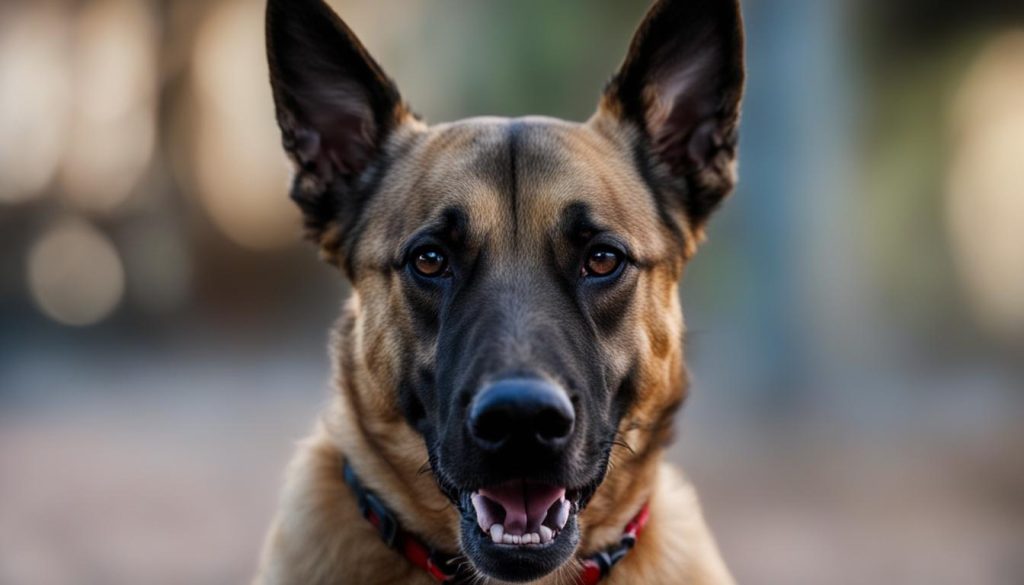
Understanding and recognizing signs of aggression in dogs is crucial for the safety of both humans and other animals. By being aware of these signs, you can take necessary precautions to prevent potential dog fights and handle aggressive behavior effectively. Here are some key indicators to look out for:
1. Hard Staring:
When a dog is about to display aggressive behavior, they may engage in hard staring. This is often accompanied by a stiff body posture and a focused gaze. It’s important to recognize this behavior as a potential warning sign and take appropriate action.
2. Raised Hackles:
When a dog feels threatened or anxious, their hackles, or the hair along their back, may become raised. This can indicate that the dog is on edge and ready to defend itself. It’s important to respect their boundaries and avoid any actions that may escalate the situation.
3. Freezing:
Another sign of aggression in dogs is freezing. This involves the dog becoming completely still, often with their body tense and their gaze fixed on a specific target. Freezing is a sign that the dog is preparing to act aggressively, and it’s important to give them space and avoid any sudden movements that may trigger a defensive response.
4. Head Lowering:
Head lowering is a submissive behavior that dogs may display when they feel threatened or fearful. However, in some cases, it can also be a precursor to aggression. It’s important to assess the overall body language of the dog and look for other signs of aggression to determine their intent accurately.
Recognizing these signs of aggression in dogs is essential for preventing and managing potentially dangerous situations. If you observe any of these behaviors, it’s crucial to remove yourself or others from the immediate vicinity and seek professional help if necessary. Remember, your safety should always be the top priority when dealing with aggressive dogs.
Recovering After a Dog Fight
After a dog fight, it is important to handle the dogs appropriately to ensure their safety and well-being. The first step is to separate the dogs to prevent any further aggression. Provide a calm and comforting environment to help them relax and recover from the intense experience. Checking for injuries is crucial, as dog fights can result in bite wounds or other injuries that may require veterinary attention.
When examining the dogs, carefully look for any signs of visible wounds or bleeding. If you notice any injuries, it is advisable to consult a veterinarian to assess the extent of the damage and provide appropriate treatment. It is important to handle the dogs with care and avoid putting yourself at risk, especially if one or both dogs are still agitated or aggressive.
Once the dogs have been separated and any injuries have been addressed, it is crucial to provide them with a safe and secure environment for rest and recovery. Keep them in a quiet area away from any potential triggers that could reignite aggression. Provide comfortable bedding, toys, and treats to help them feel secure and loved.
| Steps to Recover After a Dog Fight |
|---|
| Separate the dogs to prevent further aggression |
| Check for visible injuries and consult a vet if necessary |
| Provide a calm and comforting environment |
| Keep the dogs in a safe and secure area for rest and recovery |
During the recovery period, closely monitor the dogs for any signs of physical discomfort, changes in behavior, or recurring aggression. If you notice any concerning symptoms, it is best to seek professional guidance from a veterinarian or a certified dog behaviorist.
Understanding Different Types of Dog Fights

When it comes to dog fights, there are different types based on the intensity and behavior displayed. Understanding these types can help determine the most appropriate intervention technique to break up the fight safely and effectively.
Scuffle Fights
Scuffle fights are characterized by no actual bite contact between the dogs. It involves posturing, growling, and snapping, but without any serious attempts to cause harm. These fights are often a result of social jockeying or establishing dominance.
Scissor Fights
In scissor fights, the dogs make bite attempts but do not engage in grab-and-hold biting. They may nip or snap at each other, but the fight lacks the severity and intensity of a full-blown grab fight. Scissor fights can be triggered by competition over resources or territory.
Grab Fights
Grab fights are the most serious and dangerous type of dog fight. They involve severe biting and holding onto each other. These fights can cause serious injuries to both dogs involved. Grab fights often stem from intense aggression or a strong desire to establish dominance.
By understanding the different types of dog fights, you can tailor your intervention technique to effectively break up the fight and ensure the safety of all dogs involved. Remember, it is crucial to prioritize your own safety, and seeking professional help may be necessary in some cases.
| Type of Dog Fight | Description |
|---|---|
| Scuffle Fights | No actual bite contact, characterized by posturing and growling. |
| Scissor Fights | Bite attempts without grab-and-hold biting. |
| Grab Fights | Severe biting and holding onto each other. |
Understanding the different types of dog fights is crucial in ensuring the safety and well-being of all dogs involved. By recognizing the behaviors and severity of the fight, you can intervene appropriately and prevent further harm. Remember, your safety is paramount, and it may be necessary to seek professional assistance in managing aggressive dog behavior.
Knowing When to Intervene in a Dog Fight
When witnessing a dog fight, it is crucial to assess the situation carefully before deciding to intervene. While it is natural to want to protect the dogs involved, it is important to prioritize your safety and the well-being of the animals. Consider the following factors to determine when it is appropriate to step in:
- Intensity of the fight: Assess the level of aggression and the potential risk of injury. If the fight is intense and poses a significant danger, it may be best to seek help or wait until the dogs separate on their own.
- Size and strength of the dogs: Take into account the size and strength of the dogs involved. Breaking up a fight between large, powerful breeds can be extremely challenging and potentially dangerous.
- Severity of the aggression: Evaluate the severity of the aggression displayed by the dogs. If it appears that one dog is inflicting serious harm on the other, immediate intervention may be necessary to prevent further injury.
- Your own safety: Consider your own safety and the potential risks involved in intervening. If attempting to break up the fight puts you at a high risk of injury, it may be best to stay back and seek professional assistance.
- Available resources: Assess if there are any available resources nearby that can help safely separate the dogs, such as a barrier or distraction tools.
Remember, every situation is unique, and there is no one-size-fits-all approach. Trust your judgment, and if in doubt, consult with a professional dog trainer or animal behaviorist for guidance.
If you do decide to intervene, it is crucial to use caution and employ safe dog fight intervention techniques to minimize the risk of injury to yourself and the dogs.
When to Stay Out of a Dog Fight
Knowing when to stay out of a dog fight is crucial for your safety and the well-being of the dogs involved. While it’s important to intervene whenever possible, there are situations where attempting to break up a fight could put you at serious risk of injury. Here are some scenarios where it may be best to stay out of a dog fight:
- If the dogs are displaying extreme aggression, such as lunging, biting, or attacking with intent to kill, it’s safest to avoid getting involved. Trying to separate dogs in this state can result in severe injuries to all parties involved.
- If the size or strength of the dogs is disproportionate and could pose a significant danger to you, it’s advisable to seek help from trained professionals instead of intervening yourself.
- In cases where you don’t have access to the necessary tools or techniques to safely break up the fight, it’s better to wait for help or for the dogs to separate on their own.
Remember, your safety should always be the top priority. If you find yourself in a situation where you can’t safely intervene, it’s crucial to remove yourself from the immediate vicinity and seek assistance from trained professionals or authorities. By staying out of a dog fight when necessary, you can prevent further harm and ensure the safety of everyone involved.
Table: When to Stay Out of a Dog Fight
| Scenario | Action |
|---|---|
| Extreme aggression, intent to kill | Stay out of the fight |
| Disproportionate size or strength | Seek help from professionals |
| Lack of tools or techniques | Wait for help or for dogs to separate |
Dog Fight Prevention Tips
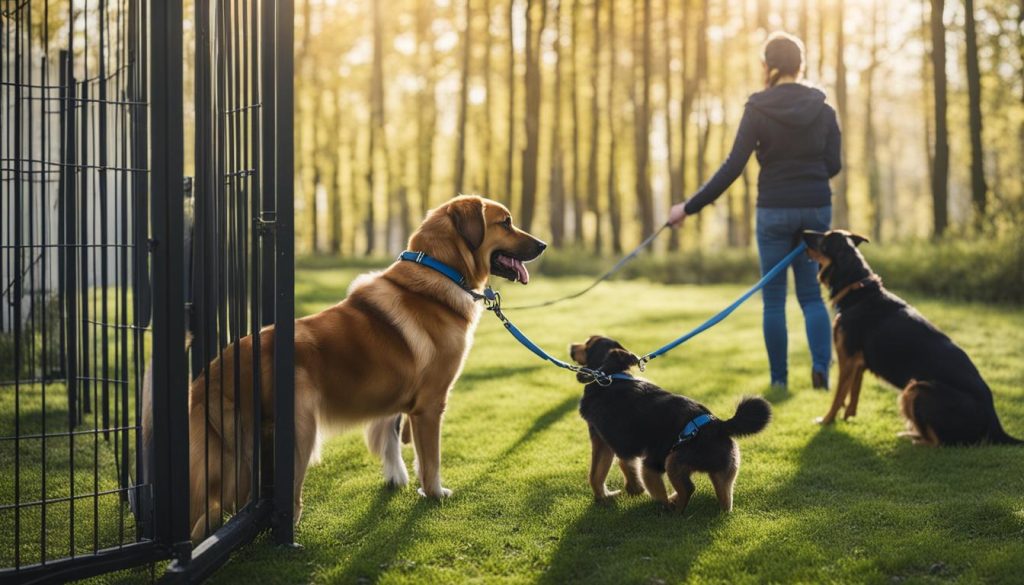
Preventing dog fights is crucial for the safety of both your own dog and others. By implementing effective strategies and being a responsible dog owner, you can significantly reduce the risk of dog fights occurring.
1. Proper Socialization
Socialization plays a key role in preventing dog fights. Expose your dog to various environments, people, and other animals from an early age. This helps them develop positive associations and reduces the likelihood of fear or aggression towards unfamiliar situations or individuals. Enroll your dog in obedience classes or hire a professional trainer to assist with socialization if needed.
2. Supervise Interactions
Always supervise your dog when they are interacting with other dogs, especially if they have a history of aggression or reactivity. Keep a close eye on their body language for any signs of tension or stress. If you notice any warning signs, such as stiffening, growling, or raised hackles, separate the dogs immediately before the situation escalates into a fight.
3. Manage Resources
Resource guarding, where a dog becomes possessive and aggressive over items like food, toys, or bedding, can trigger fights. To prevent this, establish clear rules and boundaries around resources. Feed dogs in separate areas or use barriers to create distance during meal times. Provide plenty of toys and rotate them regularly to minimize the chances of conflict over possessions.
4. Avoid Triggers
Be aware of your dog’s triggers and take steps to avoid them. If you know your dog becomes reactive around certain stimuli, such as other dogs, loud noises, or crowded areas, steer clear of those situations when possible. By proactively managing their environment, you can reduce the likelihood of confrontations and keep everyone safe.
5. Spay/Neuter Your Dog
Spaying or neutering your dog can help reduce their aggression levels and overall territorial behavior. This procedure can also prevent fights related to mating instincts, as intact dogs may be more prone to aggression when seeking a mate. Consult with your veterinarian about the appropriate age and timing for spaying or neutering your dog.
6. Seek Professional Help
If your dog has a history of aggression or has been involved in previous fights, consulting with a professional dog trainer or behaviorist is recommended. They can assess your dog’s behavior, provide personalized training plans, and assist you in implementing effective management strategies to prevent future conflicts.
Wrapping Up
Handling dog fights effectively requires understanding dog behavior and implementing prevention strategies. By prioritizing safety and the well-being of the dogs involved, you can minimize the risk of injuries and keep everyone safe.
Recognizing signs of aggression and stress in dogs is key to preventing fights. By learning to read their body language, such as growling, tucking the tail, or flattened ears, you can anticipate potential conflicts and remove your dog from triggering situations.
When a dog fight does occur, it’s important to intervene safely. Distraction techniques like loud noises or spraying water can help redirect their attention. Physical separation using objects like a metal garbage can lid or the wheelbarrow technique can be effective in breaking up the fight. Always prioritize your safety and avoid direct contact with the dogs’ mouths.
Consulting with professionals and seeking veterinary care when necessary is crucial in managing dog fights and aggressive behavior. Their expertise can provide guidance on effective strategies and ensure the best outcome for all involved.
FAQ
What are some signs of aggression or stress in dogs?
Signs of aggression or stress in dogs can include growling, tucking the tail, flattened ears, whale eye (showing the whites of the eyes), lip licking, pacing, and excessive sniffing.
How can I break up a dog fight safely?
To break up a dog fight safely, you can use distraction techniques like loud noises or spraying water, physically separate the dogs using objects like a metal garbage can lid or a chair, or use the wheelbarrow technique with the help of another person.
What should I do after a dog fight?
After a dog fight, it’s important to separate the dogs and provide a calm and comforting environment. Check both dogs for injuries and seek veterinary attention if necessary. Keep the dogs in a safe place and allow them plenty of rest and treats to aid in their recovery.
How can I prevent dog fights?
Dog fights can be prevented by understanding triggers for aggressive behavior, such as resource guarding or lack of socialization. Anticipate potential fights by removing your dog from triggering situations and practicing responsible dog ownership, including using a muzzle if necessary.
How can I recognize signs of aggression in dogs?
Signs of aggression in dogs can include hard staring, head lowering, raised hackles, freezing, sudden stillness, and other body language cues. It’s important to be aware of these signals both in your own dog and other dogs you encounter.
When should I intervene in a dog fight?
It’s important to assess the situation and prioritize your safety when deciding to intervene in a dog fight. If the fight poses a high risk of injury, it may be best to seek help or wait until the dogs separate on their own. Consider factors like the size of the dogs and the severity of the aggression.
What should I do if I can’t break up a dog fight safely?
If attempting to break up a dog fight would put you at serious risk of injury, it’s best to stay out of it. Your safety should always be the top priority, and sometimes it’s better to let the fight resolve on its own.
How can I prevent dog fights?
Dog fights can be prevented by understanding triggers for aggressive behavior, such as resource guarding or lack of socialization. Anticipate potential fights by removing your dog from triggering situations and practicing responsible dog ownership, including using a muzzle if necessary.
What are some tips for preventing dog fights?
To prevent dog fights, it’s important to practice responsible dog ownership, anticipate potential triggers, and remove your dog from triggering situations. Avoid outings if your dog has a history of aggression and closely monitor resources like food and toys to prevent resource guarding.


